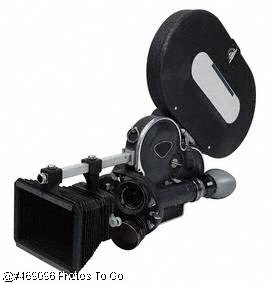You know you've got more talent than Oliver Stone, but you've never had the budget to prove it. Well, in
the world of promos you never will. But what you can prove to the world is how incredibly good you can be at creating
something for nothing.
Promo producers learn to become Jacks of all trades, and masters of quite a few of them. They write, direct,
act, edit, mix, do the graphics, sometimes even have to do the voice overs...and they have to do it all well. The
more they do, the more they learn how to get it done better, faster, cheaper than anything else out there. And once you get
a good sense of that, you are well on your way to becoming a force in this business.
You do NOT need to shoot 35mm to make something look great. You do NOT even need to shoot 16mm to look like
film. You can shoot with a crappy little 1-CCD DV camera and make greatness...as long as you have planned out what you are
doing and figured out how to make your vision a reality. I can't say it enough. Before you roll a frame, make the whole spot
work in your head shot for shot.
The best example I ever saw was from Disney in Singapore. The finished spot looked like it had a massive
budget, (I'm talking absolutely huge), but the producer told me it cost about US$50. And most of that was spent of coffee.
To prove it, he made a short film documenting the process from start to finish (shown at Promax Singapore 2001, maybe the
tape is still available to view). I have never seen a better example of someone using everything they've ever picked up to
make something fantastic. This spot has won a heap of awards, blowing out competitors that did have the big budgets. Just
proves, if you know what you're doing and have the vision to see it through, money doesn't matter. I can't rave enough about
this spot...but I'll try. Shot on Betacam ended up looking like 35mm. All elements/talent were shot individually on
a small locked off blue screen. End result is a massive flight control centre, all talent perfectly placed throughout complete
with posted dolly and tracking shots...and a very real looking set that would have cost the bomb to construct. All talent
were his co-workers, and most of the graphics and CG were done for free by an intern. When asked how he did it, he had a one
word reply. "Planning".
The excellent answer. And something I'm sure his co-workers have picked up from him. There is nothing
stopping you from doing the same level work as this but you. I know, you don't have access to a free CG artist...you don't
have decent equipment to work with...you don't have a decent edit suite. Who cares? You want to do it, you better figure a
way how. Use your friends, learn some graphic programs yourself, read books on writing, acting, directing and blocking. Learn.
Then, the best part...figuring out how to make something look great and hideously expensive for no money at all. American
Cinematographer is another great resource. Here's a monthly magazine with some of the world's most expensive productions
and most of them end up creating an in-camera effect using stuff you could find around the house. Read the articles
carefully and you'll see what I mean. Shooting through your mom's cassarole dish might get you that effect you're
looking for, filming through an aquarium with a blue screen background might give you a weird layer you can add in later...on
and on. And why am I talking about post production on the production page? Just like the man said, planning. In order to get
the best out of yourself and your production, you of all people need to know how the whole thing is going to come together
long before you start.
So, you want to make Lord of the Rings and you have no budget and no dwarfs. Where do you start? In
your head. Look around and tally up what you really do have to work with. You have access to a camera, maybe a cameraman and
crew, you've got friends who can be talent or maybe an amateur actors group dying for their shot at fame, you've got all sorts
of stuff lying around your house and sitting on your desk, you've got a blue screen in the studio. Add it all up, there's
something there. Still stuck? Go and talk to people. One thing about the tv business, people never get tired of giving you
advice, especially if you ask them with respect. That mean old guy in the studio just happens to have been working in this
business for 25 years...summon up the courage and ask him how it would be possible to do what you want. He might know. Or
he might know someone who would. And chances are he'll be flattered you asked him.
ON LOCATION
Production rule #1...make the job fun. If you're a tyrant, you're going to get a lot less out of people
than if you are a team leader. Stuff your ego and pump up everyone else's. It works every time.
#2...before you roll a frame, make sure you can see the entire finished promo frame by frame,
edit by edit in your head. If you have trouble visualizing then draw a storyboard. Doesn't matter if you can't draw better
than 5 year old. Sam Raimi draws worse than my kids...but he does it anyway and he's a bigtime Hollywood director. He does
it because he needs to make sure that everyone understands what they're making. And so do you.
#3...if you're working with a crew, no matter how small...just like Sam, make sure everyone knows what you're
going for and how you want to get it.
#4...if you're shooting, figure out the best and most economical way to get it done. This ain't hollywood,
but it ain't public access tv either. If you need to shoot in sequence, fine go ahead. If you need to break the action down
and shoot out of sequence, make sure you keep a clipboard noting what you've got and what you need. You'll kick yourself later.
#5...pay attention to the little things. The background, the background action, the ambient noise...everything.
Remember, you can cheat things around...this is television after all.
#6...shoot everything you need plus everything else. You can never have enough footage to use, and that
will become obvious when you're editing. And then it's too late.
#7...if you're shooting a specific action, block it out. Shoot it as you want it until you're happy, then
change it a little. If you've got the time, do it tighter, wider, 2 shot, medium shot, close up.
#8...watch the masters and wonder why they do what they do. Look at Jaws and see how they highlight tension
visually without saying anything. Its not the lighting, not the music...it's how the camera moves...specifically, with purpose.
There's a subtle visual language that your audience understands from films. Use those techniques to your advantage.
#9...work with kids and animals only under threat of death. W.C. Fields was right about that one. If you
do have to work with the little critters, make sure there's something around to make them happy in the down time.
#10...lighting. Learn it. Understand it. Never take it for granted.
#11...doesn't matter if you trust the cameraman and sound guy with your life. Check through the viewfinder,
do playback spot checks. Do it.
#12...never use 'we'll fix it in post'. That does not exist in your vocabulary...even if its true. If you
can get it right while filming, then get it right.
#13...some producers go for an 8mm look in post. Bugger that, shoot it in super8. Here's a format that you
can't possibly screw up. Trust me. Someone you know has a super8 camera. Get it. The film is still readily available and usually
includes processing. You'll figure the camera out in 5 minutes. More than likely you'll have to send the film to another city
for processing though. Put a rush on it and it will be back in your hands in a week. Getting it on video only requires a projector,
a white card and a video camera. Looks great. Once you've done that...maybe you'll want to tool around with a bolex 16mm...again,
a camera designed for promo makers. Have a play with one and see if you like it.
#14...filters. An endless world of fun. Gradiated filters to change the colour of the sky, fog filters to
erase wrinkles or to add that Playboy channel look, star filters for 70's lighting effect. Play around with them and find
something you like. If you have a quality cameraman, he'll be able to explain everything to you and then introduce you to
colured filters that remove color, not add them.
IN STUDIO
Now you're in a controlled environment armed with all the rules of above. Doesn't mean it gets any easier,
just means you won't get rained on.
This can be your land of blue screen and black drop cloth. The secret of both, even lighting. Ask your studio
cameramen...they'll walk you through how to get a good key.
What about sets? What about dollies and tracking shots, what about steadicam? What about nude scenes? Hey,
if that's all you've got to worry about then you're obviously on your way. Don't worry, as this site progresses people will
be adding comments for you to use, so check back once in a while.




